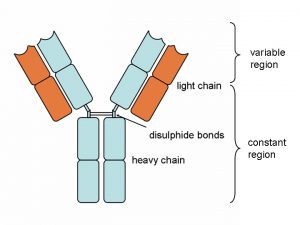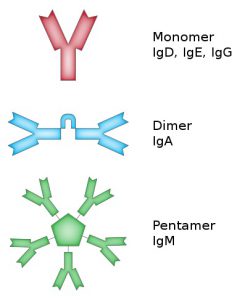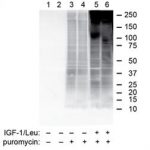Antibodies 101

Antibody structure
Antibodies are Y-shaped proteins produced naturally by the body’s immune system when it detects foreign substances. These proteins are commonly used in research to identify, locate and visualize intracellular and extracellular proteins. Antibodies are also being used for clinical applications, in particular as cancer therapeutics and in vaccine development. Here you’ll find a quick overview of antibodies, their applications and the terminology often used when discussing these important proteins.
The body produces antibodies in response to foreign substances, called antigens. Examples of antigens can be chemicals or microorganisms such as bacteria, viruses or parasites. An antibody consists of two identical heavy chains, as well as two identical light chains. The chains have a variable region (V), which binds to specific targets (called epitopes) on the antigen, as well as a constant region (C), which interacts with white blood cells and other molecules in the immune system.
The constant region also determines an antibody’s isostype, or class. Different isotypes have different functions and locations within the body. In mammals, there are five antibody isotypes:
-

The different antibody isotopes. Credit: Martin Brändli.
IgD: functions mainly as an antigen receptor on B cells that have not been exposed to antigens
- IgE: binds to allergens and triggers histamine release from mast cells and basophils. It is also involved in immunity to parasites. The Kerafast catalog includes an IgE Antibody from Virginia Commonwealth University.
- IgG: provides the most antibody-based immunity against invading pathogens. It is also the only antibody capable of crossing the placenta. Many of our antibodies are of an IgG isotype, including the DNA-RNA hybrid and puromycin antibodies, and we also offer IgG Antibodies from Beth Israel Deaconess Medical Center.
- IgA: found in mucosal areas, such as the gut and respiratory tract, as well as in saliva, tears and breast milk. An example IgA antibody is our CD36 Antibody from Cornell University.
- IgM: expressed on the surface of B cells (as a monomer) and in a secreted form (as a pentamer) with very high avidity. Our Aspergillus fumigatus Antibodies from University of Georgia are all examples of IgM antibodies.
Other antibody isotypes are present in non-mammals; for example, IgY is found in birds and reptiles. Example IgY antibodies in our catalog include the Chicken Polycystin Antibody from Johns Hopkins University and Chicken GFP Antibody from University of Michigan.
Antibodies can also be divided into polyclonal and monoclonal antibodies. Polyclonal antibodies (pAbs), which are secreted by different B cell lineages within the body, recognize multiple epitopes on any one antigen. In contrast, monoclonal antibodies (mAbs) are homogeneous, coming from a single B cell clone and consisting of only one antibody subtype, and detect only one epitope on the antigen.

Example Western Blot analysis data, of our puromycin antibody from Penn State College of Medicine
Antibodies are used for a variety of research applications to identify and locate proteins. Example applications include:
- Western Blot (WB): identify proteins separated by electrophoresis
- Flow Cytometry: differentiate cell types by the proteins they express
- Immunohistochemistry (IHC) and immunofluorescence (IF): visualize with a microscope to examine protein expression
- ELISA: detect and quantify proteins
Antibodies are also used for clinical applications. For example, ELISA is used in pregnancy and HIV tests, as well as many other diagnostics. In addition, monoclonal antibodies are leveraged in certain forms of immunotherapy to target cells or proteins. Disease areas currently using monoclonal antibody therapy include multiple sclerosis, rheumatoid arthritis, Alzheimer’s disease and different cancers. In cancer, monoclonal antibodies can help make cancer cells more visible to the immune system, stop new blood vessels from forming, or block cell growth. The antibodies can also be engineered to deliver radiation or chemotherapy to cancer cells.
To conclude, antibodies are being used for a variety of research and clinical applications. The antibodies in the Kerafast catalog, made available by academic investigators worldwide, can be used to detect anything from the Zika virus to biotin to DNA-RNA hybrids. Our full list of available antibodies can be found here.


